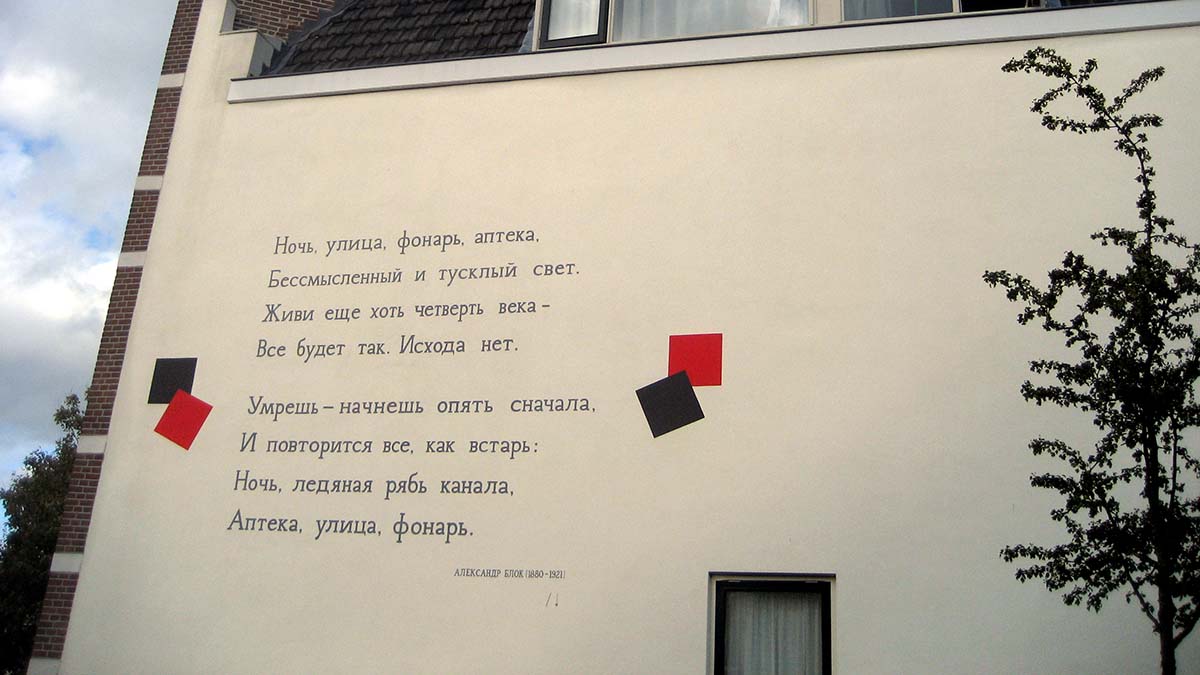
The Words of the Poet Are Written On Sleutelstaat Walls
by Giuseppe Raudino
As I walked in the historic center of Leiden, the Netherlands, I noticed some words written on a wall. It was neither a commercial advertisement nor a street sign. As I stepped closer I had a wonderful surprise: it was a poem.
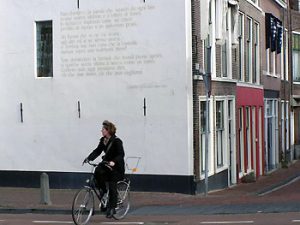 I knew the Dutch people decorating houses and buildings elaborate façades , but a poem written on a wall was completely new to me. As I realized later, that this custom had started in 1992 with a literature project named “Muurgedichten” (wallpoems). The project was a private initiative by the artistic foundation “Tegen-Beeld” which immediately met the approval of citizens and sponsors.
I knew the Dutch people decorating houses and buildings elaborate façades , but a poem written on a wall was completely new to me. As I realized later, that this custom had started in 1992 with a literature project named “Muurgedichten” (wallpoems). The project was a private initiative by the artistic foundation “Tegen-Beeld” which immediately met the approval of citizens and sponsors.
“The poems, which were written in many different languages, are meant to be for everybody” the initiators of this project explained, underlining the “hope that passers-by are stimulated by the poems as well as by the visual image of the letters against the background formed by the wall.” The idea of a city full of poems is amazing and reflects the most noble concept of poetry, which, beyond the author, belongs to the whole mankind.
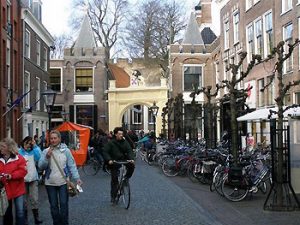 In this manner, Leiden is an international-oriented city, that welcomes its visitors with a cultural gesture that encompasses the great treasure inherited by differences among languages and people.
In this manner, Leiden is an international-oriented city, that welcomes its visitors with a cultural gesture that encompasses the great treasure inherited by differences among languages and people.
“The reader/viewer is confronted by various sorts of characters that refer to different cultures” the official website of wall poems reads. “The common thread throughout this project is that many of these poems reflect upon language, colour, or upon the life as a poet.”
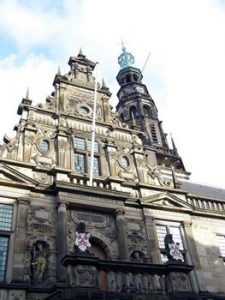 The cultural background of Leiden dates back to the sixteenth century, when the city fought against Spanish rule as an ally of William I, Prince of Orange. Because its bravery demonstrated during a siege in 1573, the prince himself afterwards visited Leiden. To reward the heroic defense, Prince William let the inhabitants choose between exemption from certain imposts or the foundation of a university. The city chose the second option and became the first university center of the Netherlands. (City Hall – left)
The cultural background of Leiden dates back to the sixteenth century, when the city fought against Spanish rule as an ally of William I, Prince of Orange. Because its bravery demonstrated during a siege in 1573, the prince himself afterwards visited Leiden. To reward the heroic defense, Prince William let the inhabitants choose between exemption from certain imposts or the foundation of a university. The city chose the second option and became the first university center of the Netherlands. (City Hall – left)
Without any doubt, the academic presence positively affected the cultural life of Leiden and its reputation, and this heritage still lasts today. Edmondo De Amicis, a prominent Italian writer and reporter, wrote in 1880: “How this university answered to the hopes of Leiden, it is superfluous to say. Everybody knows how the States of Holland with their liberal offers drew learned men from every country; how philosophy, driven out of France, took refuge there; how Leiden was for a long time the securest citadel for all men who were struggling for the triumph of human reason; how it became at length the most famous school in Europe.”
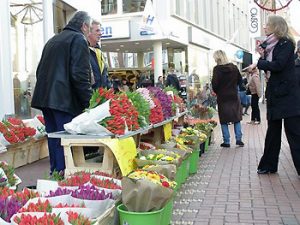 The actual university is in an ancient convent. One can not enter without a sentiment of profound respect the great hall of the Academic Senate, where are seen the portraits of all the professors who have succeeded each other from the foundation of the university up to the present day.”
The actual university is in an ancient convent. One can not enter without a sentiment of profound respect the great hall of the Academic Senate, where are seen the portraits of all the professors who have succeeded each other from the foundation of the university up to the present day.”
De Amicis travelled across the Netherlands, describing the most important highlights of this country. He referred to Leiden as “the antique Athens of the north”, “the Saragossa of the Low Countries,” adding that it certainly is “the oldest and most illustrious of the daughters of Holland” and definitely “one of those cities which make you thoughtful upon first entering them.”
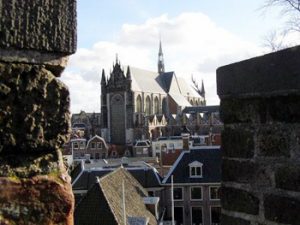 The heart of Leiden is an artificial hill at the confluence of two rivers: the Old and the New Rhine. A stronghold on the top of the earthen mound enables a 360 degrees panorama view. Unfortunately, nothing is left from the ancient city walls, but this fortification called “De Burcht” built 800 hundreds year ago is surely worth a visit. From there, it is possible to admire with a privileged perspective the imposing Hoogelandse Kerk, a Gothic church that, after Leiden was detached from Utrecht diocese, served as cathedral until the Reformation.
The heart of Leiden is an artificial hill at the confluence of two rivers: the Old and the New Rhine. A stronghold on the top of the earthen mound enables a 360 degrees panorama view. Unfortunately, nothing is left from the ancient city walls, but this fortification called “De Burcht” built 800 hundreds year ago is surely worth a visit. From there, it is possible to admire with a privileged perspective the imposing Hoogelandse Kerk, a Gothic church that, after Leiden was detached from Utrecht diocese, served as cathedral until the Reformation.
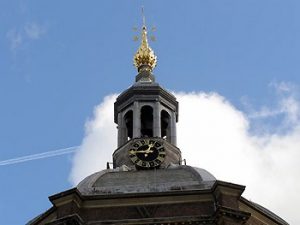 The best way to explore this city is just a random walk. Especially on Saturday, the streets are crowded with people busy in their weekly shopping activities and street sellers, who are offering a wide range of local products, from flowers to cheese. The atmosphere is overall friendly and cozy; many musicians play some instruments and you can very easily be captured by this party environment. However, never forget to look above from time to time, otherwise you could miss some nice treasures such us the Marekerk, a church that summarizes the Dutch Classicism with its octagonal-shaped dome and its height of 55 meters. On the top is a golden spire with two big keys (right). The city’s nickname is “sleutelstaat” (city of keys) because of its coat of arms and its flag, that depict two crossing skeleton keys.
The best way to explore this city is just a random walk. Especially on Saturday, the streets are crowded with people busy in their weekly shopping activities and street sellers, who are offering a wide range of local products, from flowers to cheese. The atmosphere is overall friendly and cozy; many musicians play some instruments and you can very easily be captured by this party environment. However, never forget to look above from time to time, otherwise you could miss some nice treasures such us the Marekerk, a church that summarizes the Dutch Classicism with its octagonal-shaped dome and its height of 55 meters. On the top is a golden spire with two big keys (right). The city’s nickname is “sleutelstaat” (city of keys) because of its coat of arms and its flag, that depict two crossing skeleton keys.
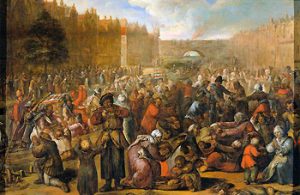 Behind any corner of this city there is a spectacular, poetic image to be captured: the Old Rhine river flows smoothly, the water mirrors elegant buildings, like a in pastel-colored painting, while many people cross wooden bridges. Incidentally, every part of Leiden actually resembles a Rembrandt’s work or a Otto van Veen’s canvas, two prominent painters who were born in Leiden and were active in the early seventeenth century.
Behind any corner of this city there is a spectacular, poetic image to be captured: the Old Rhine river flows smoothly, the water mirrors elegant buildings, like a in pastel-colored painting, while many people cross wooden bridges. Incidentally, every part of Leiden actually resembles a Rembrandt’s work or a Otto van Veen’s canvas, two prominent painters who were born in Leiden and were active in the early seventeenth century.
It’s amazing how nowadays the beauty of this city appears still the same after four centuries. To confirm this impression, compare the “Relief of Leiden” (painted in 1574 by Otto van Veen, displayed in the Rijksmuseum, Amsterdam) to any part of the city: the same colors, the same shape of the houses, the same sky and clouds, the same crowd of people can be recognized at the present days.
For More Information:
An English section of tourist information about Leiden is available on the Visit Leiden website. Visit the website of wallpoems in order to find out your favorite authors and the relevant streets in which their work appears.
The National Museum of Antiquities of Leiden hosts an archaeological collection that originates from four different regions: the Netherlands, Egypt, the Near East and the world of classical antiquity. In total, more than 80,000 objects are displayed. Don’t miss the majestic statues of the Roman emperors, prehistoric golden jewellery, Egyptian mummy cases and Etruscan masterpieces in bronze. Rijksmuseum van Oudheden
The botanical garden of Leiden is one of the oldest in the world. The garden was set up by the end of seventeenth century, and collects a wide range of plants. It is worth a visit.
Leiden Tours Now Available:
Leiden Private Tour and Canal Cruise
Private Guided Tour of Center and Prehistoric Antiquities Museum with Art Historian in Leiden
Private tour to Rotterdam, Delft and Leiden from Amsterdam
About the author:
Giuseppe Raudino graduated in Communication Science from the University of Siena, Italy. He lives in the Netherlands, where he works as a freelance writer. Besides traveling and writing, he holds a black belt in karate and plays the trumpet. Web site: www.raudino.webs.com
Photo credits:
First Leiden wall poem photo by Vysotsky (Wikimedia) / CC BY-SA
All other photos are by Guiseppe Raudino.
“Relief of Leiden”by Otto van Veen / Public domain


